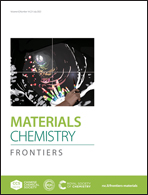Richly electron-deficient BCxO3−x anodes with enhanced reaction kinetics for sodium/potassium-ion batteries†
Abstract
Facing up to the aim of global carbon neutrality, the mass production of sodium-ion batteries (SIBs) and potassium-ion batteries (PIBs) is severely restricted by low capacities and inferior kinetics of anode materials. The prevailing graphitic carbons exhibit low and slow charge storage kinetics due to the large sizes of Na+ and K+, thus hindering their further application. Herein, through in situ doping boron into carbon nanocages, novel BCxO3−x nanocages (BCNCs) for Na+ and K+ storage promotion were prepared. Thanks to the hollow structure with thin walls and rich electron deficiencies owing to the electron-deficient nature of boron atoms, the BCNCs present excellent electrochemical stability and ultrahigh capability of Na+/K+ storage. The BCNC anode at 0.1 A g−1 delivers a high capacity of 177 mA h g−1 after 1000 cycles for SIBs and 212 mA h g−1 after 500 cycles for PIBs. The density functional theory calculations confirm that the electron deficiencies contribute to the strong adsorption energy for Na+ and K+, achieving ultrahigh reversible capacities of 769 mA h g−1 and 2493 mA h g−1 at 0.05 A g−1, respectively. Kinetic analysis demonstrates that electron deficiencies provide extra ion adsorption sites and increase the pseudocapacitive charge storage capacity, resulting in remarkable charge transfer between sodium/potassium and substrate. This work may provide vital guidance to design high-performance anode materials.

- This article is part of the themed collection: 2022 Materials Chemistry Frontiers HOT articles


 Please wait while we load your content...
Please wait while we load your content...